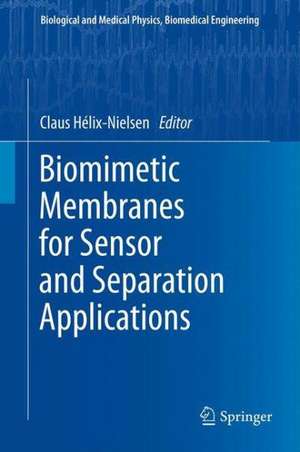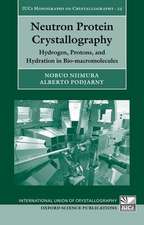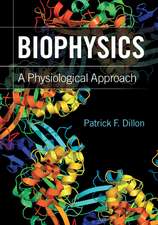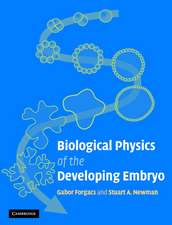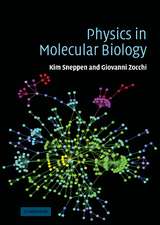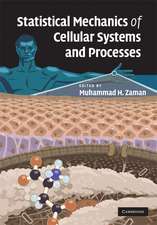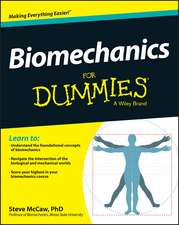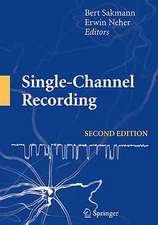Biomimetic Membranes for Sensor and Separation Applications: Biological and Medical Physics, Biomedical Engineering
Editat de Claus Hélix-Nielsenen Limba Engleză Hardback – 3 ian 2012
Once reconstituted in its final host biomimetic matrix the protein stability also needs to be maintained and controlled. Beta-barrel proteins exemplified by the E. Coli outer membrane channels or small peptides are inherently more stable than alpha-helical bundle proteins which may require additional stabilizing modifications. The challenges associated with insertion andstabilization of alpha-helical bundle proteins including many carriers and ligand and voltage gated ion (and water) channels will be discussed and exemplified using the aquaporin protein. Many biomimetic membrane applications require that the final device can be used in the macroscopic realm. Thus a biomimetic separation device must have the ability to process hundred of liters of permeate in hours – effectively demanding square-meter size membranes. Scalability is a general issue for all nano-inspired technology developments and will be addressed here in the context biomimetic membrane array fabrication. Finally a robust working biomimetic device based on membrane transport must be encapsulated and protected yet allowing massive transport though the encapsulation material. This challenge will be discussed using microfluidic design strategies as examples of how to use microfluidic systems to create and encapsulate biomimetic membranes. The book provides an overview of what is known in the field, where additional research is needed, and where the field is heading.
| Toate formatele și edițiile | Preț | Express |
|---|---|---|
| Paperback (1) | 641.20 lei 6-8 săpt. | |
| SPRINGER NETHERLANDS – 24 feb 2014 | 641.20 lei 6-8 săpt. | |
| Hardback (1) | 644.95 lei 6-8 săpt. | |
| SPRINGER NETHERLANDS – 3 ian 2012 | 644.95 lei 6-8 săpt. |
Din seria Biological and Medical Physics, Biomedical Engineering
- 5%
 Preț: 1110.32 lei
Preț: 1110.32 lei - 18%
 Preț: 1006.55 lei
Preț: 1006.55 lei - 18%
 Preț: 960.78 lei
Preț: 960.78 lei - 18%
 Preț: 704.10 lei
Preț: 704.10 lei - 18%
 Preț: 967.40 lei
Preț: 967.40 lei - 18%
 Preț: 948.92 lei
Preț: 948.92 lei - 15%
 Preț: 641.71 lei
Preț: 641.71 lei - 15%
 Preț: 644.95 lei
Preț: 644.95 lei - 15%
 Preț: 665.08 lei
Preț: 665.08 lei - 18%
 Preț: 1669.16 lei
Preț: 1669.16 lei - 18%
 Preț: 941.05 lei
Preț: 941.05 lei - 18%
 Preț: 956.81 lei
Preț: 956.81 lei - 18%
 Preț: 950.21 lei
Preț: 950.21 lei - 15%
 Preț: 636.80 lei
Preț: 636.80 lei - 18%
 Preț: 947.50 lei
Preț: 947.50 lei - 15%
 Preț: 636.80 lei
Preț: 636.80 lei -
 Preț: 397.01 lei
Preț: 397.01 lei - 18%
 Preț: 1236.99 lei
Preț: 1236.99 lei - 15%
 Preț: 644.49 lei
Preț: 644.49 lei - 18%
 Preț: 946.55 lei
Preț: 946.55 lei - 15%
 Preț: 712.22 lei
Preț: 712.22 lei - 18%
 Preț: 952.89 lei
Preț: 952.89 lei - 18%
 Preț: 944.36 lei
Preț: 944.36 lei - 18%
 Preț: 1228.29 lei
Preț: 1228.29 lei - 5%
 Preț: 1422.67 lei
Preț: 1422.67 lei - 18%
 Preț: 1393.27 lei
Preț: 1393.27 lei - 15%
 Preț: 651.19 lei
Preț: 651.19 lei - 18%
 Preț: 953.65 lei
Preț: 953.65 lei - 18%
 Preț: 955.88 lei
Preț: 955.88 lei - 5%
 Preț: 1098.48 lei
Preț: 1098.48 lei - 18%
 Preț: 959.19 lei
Preț: 959.19 lei - 15%
 Preț: 643.65 lei
Preț: 643.65 lei - 5%
 Preț: 1159.16 lei
Preț: 1159.16 lei - 5%
 Preț: 1102.67 lei
Preț: 1102.67 lei - 18%
 Preț: 952.09 lei
Preț: 952.09 lei - 18%
 Preț: 946.55 lei
Preț: 946.55 lei - 18%
 Preț: 952.09 lei
Preț: 952.09 lei - 15%
 Preț: 703.20 lei
Preț: 703.20 lei - 18%
 Preț: 953.65 lei
Preț: 953.65 lei - 5%
 Preț: 1008.41 lei
Preț: 1008.41 lei - 15%
 Preț: 644.82 lei
Preț: 644.82 lei - 18%
 Preț: 956.03 lei
Preț: 956.03 lei - 15%
 Preț: 647.40 lei
Preț: 647.40 lei
Preț: 644.95 lei
Preț vechi: 758.77 lei
-15% Nou
Puncte Express: 967
Preț estimativ în valută:
123.41€ • 128.85$ • 102.14£
123.41€ • 128.85$ • 102.14£
Carte tipărită la comandă
Livrare economică 04-18 aprilie
Preluare comenzi: 021 569.72.76
Specificații
ISBN-13: 9789400721838
ISBN-10: 9400721838
Pagini: 308
Ilustrații: XVI, 292 p.
Dimensiuni: 155 x 235 x 22 mm
Greutate: 0.54 kg
Ediția:2012
Editura: SPRINGER NETHERLANDS
Colecția Springer
Seria Biological and Medical Physics, Biomedical Engineering
Locul publicării:Dordrecht, Netherlands
ISBN-10: 9400721838
Pagini: 308
Ilustrații: XVI, 292 p.
Dimensiuni: 155 x 235 x 22 mm
Greutate: 0.54 kg
Ediția:2012
Editura: SPRINGER NETHERLANDS
Colecția Springer
Seria Biological and Medical Physics, Biomedical Engineering
Locul publicării:Dordrecht, Netherlands
Public țintă
ResearchCuprins
1 Sensing Meets Separation: Water Transport Across Biological Membranes Stanley D. Hillyard; 2 Nature Meets Technology: Forward Osmosis Membrane Technology Filicia Wicaksana, Anthony G. Fane, Chuyang Tang, and Rong Wang; 3 Polymer-Based Biomimetic Membranes for Desalination Manish Kumar, Michelle M. Payne, Sean K. Poust, and Julie L. Zilles; 4 Ion-Selective Biomimetic Membranes Henk Miedema; 5 Vesicle Arrays as Model-Membranes and Biochemical Reactor Systems Sune M. Christensen and Dimitrios Stamou; 6 Active Biomimetic Membranes Flemming Cornelius; 7 Passive Transport Across Biomimetic Membranes Karin Stibius, Sania Bäckström, and Claus Hélix-Nielsen; 8 Multi-scale Modeling of Biomimetic Membranes Hans Enggrob, Lars Yde, Mathias Gruber, and Himanshu Khandelia; 9 Regulation of Protein Function by Membrane Elastic Properties Jens A. Lundbæk and Olaf S. Andersen; 10 Large Scale Biomimetic Membrane Arrays Mark Perry, Christian Rein, and Jörg Vogel; 11 Systems for Production of Proteins for Biomimetic Membrane Devices Nicola Altamura and Giuseppe Calamita; 12 Strategies for Integrating Membrane Proteins in Biomembranes Jesper S. Hansen, Inés Plasencia, and Kamila Pszon-Bartosz; 13 Microfl uidic Encapsulation of Biomimetic Membranes Oliver Geschke; Index.
Notă biografică
The Editor, born in 1964, Lemvig, Denmark, received his PhD in Physics in 1993 from the Technical University of Denmark. After several research positions, among which a postdoctoral fellowship at the Weill Medical College, Cornell University (1995-2000), he became an associate professor at the Technical University of Denmark. Currently he is the Research Director at Aquaporin, Lyngby, Denmark.
Textul de pe ultima copertă
This book addresses the possibilities and challenges in mimicking biological membranes and creating membrane-based sensor and separation devices. It covers recent advances in developing biomimetic membranes for technological applications with a focus on the use of integral membrane protein mediated transport. It describes the fundamentals of biosensing as well as separation and shows how the two processes work together in biological systems. The book provides an overview of the current state of the art, points to areas that need further investigation and anticipates future directions in the field.
Biomimetics is a truly cross-disciplinary approach and this is exemplified by the challenges in mimicking osmotic processes as they occur in nature using aquaporin protein water channels as central building blocks. In the development of a biomimetic sensor/separation technology, both channel and carrier proteins are important and examples of how these may be reconstituted and controlled in biomimetic membranes are presented. Also new developments in our understanding of the reciprocal coupling between the material properties of the biomimetic matrix and the embedded proteins are discussed. The basic concepts of membrane barrier properties are introduced and discussed in terms of lipid and polymer based membranes. Once a given protein is reconstituted in its final host biomimetic matrix, its stability needs to be maintained and controlled and the challenges associated with insertion and stabilization of alpha-helical bundle proteins are exemplified with aquaporin and ion channels as well as sodium-potassium ATPase proteins.
The concept of multi-scale modeling is introduced and exemplified by the use of molecular dynamics, dissipative particle dynamics, and computational fluid dynamics simulations illustrating the issues involved in developing and describing biomimetic systems in a wide range of time and length scales. Scalabilityis a general issue for all nano-inspired technology developments and many biomimetic membrane applications require that the device can be used in the macroscopic realm. This challenge is addressed here in the context of fabricating biomimetic components, membrane arrays, and compartmentalized systems together with the challenges related to microfluidic design strategies for biomimetic device developments.
Biomimetics is a truly cross-disciplinary approach and this is exemplified by the challenges in mimicking osmotic processes as they occur in nature using aquaporin protein water channels as central building blocks. In the development of a biomimetic sensor/separation technology, both channel and carrier proteins are important and examples of how these may be reconstituted and controlled in biomimetic membranes are presented. Also new developments in our understanding of the reciprocal coupling between the material properties of the biomimetic matrix and the embedded proteins are discussed. The basic concepts of membrane barrier properties are introduced and discussed in terms of lipid and polymer based membranes. Once a given protein is reconstituted in its final host biomimetic matrix, its stability needs to be maintained and controlled and the challenges associated with insertion and stabilization of alpha-helical bundle proteins are exemplified with aquaporin and ion channels as well as sodium-potassium ATPase proteins.
The concept of multi-scale modeling is introduced and exemplified by the use of molecular dynamics, dissipative particle dynamics, and computational fluid dynamics simulations illustrating the issues involved in developing and describing biomimetic systems in a wide range of time and length scales. Scalabilityis a general issue for all nano-inspired technology developments and many biomimetic membrane applications require that the device can be used in the macroscopic realm. This challenge is addressed here in the context of fabricating biomimetic components, membrane arrays, and compartmentalized systems together with the challenges related to microfluidic design strategies for biomimetic device developments.
Caracteristici
A state-of-the-art Work on advances in developing biomimetic membranes for technological applications Provides an overview of what is known in the field, where additional research is needed, and where the field is heading An associate professor at Denmark Technical University and the Research Director at Aquaporin, the editor is at home both on the theoretical side and on the applied side of his subject
